PySide6.QtGui.QColor¶
- class QColor¶
The
QColorclass provides colors based on RGB, HSV or CMYK values. More…Synopsis¶
Methods¶
def
__init__()def
__reduce__()def
__repr__()def
__setstate__()def
__str__()def
alpha()def
alphaF()def
black()def
blackF()def
blue()def
blueF()def
convertTo()def
cyan()def
cyanF()def
darker()def
getCmyk()def
getCmykF()def
getHsl()def
getHslF()def
getHsv()def
getHsvF()def
getRgb()def
getRgbF()def
green()def
greenF()def
hslHue()def
hslHueF()def
hslSaturation()def
hslSaturationF()def
hsvHue()def
hsvHueF()def
hsvSaturation()def
hsvSaturationF()def
hue()def
hueF()def
isValid()def
lighter()def
lightness()def
lightnessF()def
magenta()def
magentaF()def
name()def
__ne__()def
operator=()def
__eq__()def
red()def
redF()def
rgb()def
rgba()def
rgba64()def
saturation()def
saturationF()def
setAlpha()def
setAlphaF()def
setBlue()def
setBlueF()def
setCmyk()def
setCmykF()def
setGreen()def
setGreenF()def
setHsl()def
setHslF()def
setHsv()def
setHsvF()def
setNamedColor()def
setRed()def
setRedF()def
setRgb()def
setRgbF()def
setRgba()def
setRgba64()def
spec()def
toCmyk()def
toExtendedRgb()def
toHsl()def
toHsv()def
toRgb()def
toTuple()def
value()def
valueF()def
yellow()def
yellowF()
Static functions¶
def
colorNames()def
fromCmyk()def
fromCmykF()def
fromHsl()def
fromHslF()def
fromHsv()def
fromHsvF()def
fromRgb()def
fromRgbF()def
fromRgba()def
fromRgba64()def
fromString()def
isValidColor()
Note
This documentation may contain snippets that were automatically translated from C++ to Python. We always welcome contributions to the snippet translation. If you see an issue with the translation, you can also let us know by creating a ticket on https:/bugreports.qt.io/projects/PYSIDE
Detailed Description¶
Warning
This section contains snippets that were automatically translated from C++ to Python and may contain errors.
A color is normally specified in terms of RGB (red, green, and blue) components, but it is also possible to specify it in terms of HSV (hue, saturation, and value) and CMYK (cyan, magenta, yellow and black) components. In addition a color can be specified using a color name. The color name can be any of the SVG 1.0 color names.
RGB
HSV
CMYK
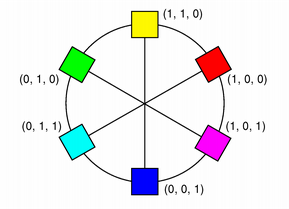
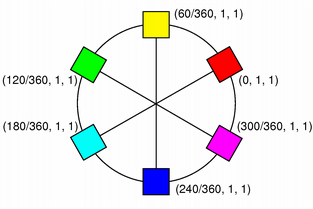
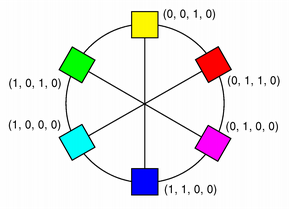
The
QColorconstructor creates the color based on RGB values. To create aQColorbased on either HSV or CMYK values, use thetoHsv()andtoCmyk()functions respectively. These functions return a copy of the color using the desired format. In addition the staticfromRgb(),fromHsv()andfromCmyk()functions create colors from the specified values. Alternatively, a color can be converted to any of the three formats using theconvertTo()function (returning a copy of the color in the desired format), or any of thesetRgb(),setHsv()andsetCmyk()functions altering this color’s format. Thespec()function tells how the color was specified.A color can be set by passing an RGB string (such as “#112233”), or an ARGB string (such as “#ff112233”) or a color name (such as “blue”), to the
fromString()function. The color names are taken from the SVG 1.0 color names. Thename()function returns the name of the color in the format “#RRGGBB”. Colors can also be set usingsetRgb(),setHsv()andsetCmyk(). To get a lighter or darker color use thelighter()anddarker()functions respectively.The
isValid()function indicates whether aQColoris legal at all. For example, a RGB color with RGB values out of range is illegal. For performance reasons,QColormostly disregards illegal colors, and for that reason, the result of using an invalid color is undefined.The color components can be retrieved individually, e.g with
red(),hue()andcyan(). The values of the color components can also be retrieved in one go using thegetRgb(),getHsv()andgetCmyk()functions. Using the RGB color model, the color components can in addition be accessed withrgb().There are several related non-members:
QRgbis a typdef for an unsigned int representing the RGB value triplet (r, g, b). Note that it also can hold a value for the alpha-channel (for more information, see theAlpha-Blended Drawingsection). TheqRed(),qBlue()andqGreen()functions return the respective component of the givenQRgbvalue, while theqRgb()andqRgba()functions create and return theQRgbtriplet based on the given component values. Finally, theqAlpha()function returns the alpha component of the providedQRgb, and theqGray()function calculates and return a gray value based on the given value.QColoris platform and device independent. The QColormap class maps the color to the hardware.For more information about painting in general, see the Paint System documentation.
Integer vs. Floating Point Precision¶
QColorsupports floating point precision and provides floating point versions of all the color components functions, e.g.getRgbF(),hueF()andfromCmykF(). Note that since the components are stored using 16-bit integers, there might be minor deviations between the values set using, for example,setRgbF()and the values returned by thegetRgbF()function due to rounding.While the integer based functions take values in the range 0-255 (except
hue()which must have values within the range 0-359), the floating point functions accept values in the range 0.0 - 1.0.Alpha-Blended Drawing¶
QColoralso support alpha-blended outlining and filling. The alpha channel of a color specifies the transparency effect, 0 represents a fully transparent color, while 255 represents a fully opaque color. For example:# Specify semi-transparent red painter.setBrush(QColor(255, 0, 0, 127)) painter.drawRect(0, 0, width() / 2, height()) # Specify semi-transparent blue painter.setBrush(QColor(0, 0, 255, 127)) painter.drawRect(0, 0, width(), height() / 2)
The code above produces the following output:
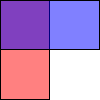
The alpha channel of a color can be retrieved and set using the
alpha()andsetAlpha()functions if its value is an integer, andalphaF()andsetAlphaF()if its value is float. By default, the alpha-channel is set to 255 (opaque). To retrieve and set all the RGB color components (including the alpha-channel) in one go, use thergba()andsetRgba()functions.Predefined Colors¶
There are 20 predefined
QColorobjects in theQColorConstantsnamespace, including black, white, primary and secondary colors, darker versions of these colors, and three shades of gray. Furthermore, theQColorConstants::Svgnamespace definesQColorobjects for the standard SVG color keyword names .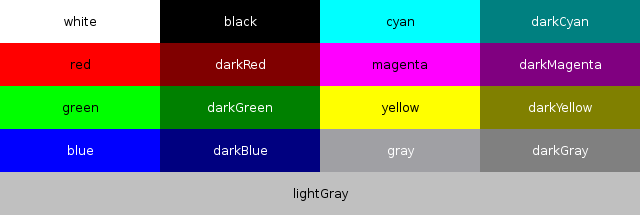
The
QColorConstants::Color0,QColorConstants::Color1andQColorConstants::Transparentcolors are used for special purposes.QColorConstants::Color0(zero pixel value) andQColorConstants::Color1(non-zero pixel value) are special colors for drawing in QBitmaps. Painting withQColorConstants::Color0sets the bitmap bits to 0 (transparent; i.e., background), and painting with c{QColorConstants::Color1} sets the bits to 1 (opaque; i.e., foreground).QColorConstants::Transparentis used to indicate a transparent pixel. When painting with this value, a pixel value will be used that is appropriate for the underlying pixel format in use.For historical reasons, the 20 predefined colors are also available in the Qt::GlobalColor enumeration.
Finally,
QColorrecognizes a variety of color names (as strings); the staticcolorNames()function returns a QStringList color names thatQColorknows about.The Extended RGB Color Model¶
The extended RGB color model, also known as the scRGB color space, is the same the RGB color model except it allows values under 0.0, and over 1.0. This makes it possible to represent colors that would otherwise be outside the range of the RGB colorspace but still use the same values for colors inside the RGB colorspace.
The HSV Color Model¶
The RGB model is hardware-oriented. Its representation is close to what most monitors show. In contrast, HSV represents color in a way more suited to the human perception of color. For example, the relationships “stronger than”, “darker than”, and “the opposite of” are easily expressed in HSV but are much harder to express in RGB.
HSV, like RGB, has three components:
H, for hue, is in the range 0 to 359 if the color is chromatic (not gray), or meaningless if it is gray. It represents degrees on the color wheel familiar to most people. Red is 0 (degrees), green is 120, and blue is 240.

S, for saturation, is in the range 0 to 255, and the bigger it is, the stronger the color is. Grayish colors have saturation near 0; very strong colors have saturation near 255.

V, for value, is in the range 0 to 255 and represents lightness or brightness of the color. 0 is black; 255 is as far from black as possible.

Here are some examples: pure red is H=0, S=255, V=255; a dark red, moving slightly towards the magenta, could be H=350 (equivalent to -10), S=255, V=180; a grayish light red could have H about 0 (say 350-359 or 0-10), S about 50-100, and S=255.
Qt returns a hue value of -1 for achromatic colors. If you pass a hue value that is too large, Qt forces it into range. Hue 360 or 720 is treated as 0; hue 540 is treated as 180.
In addition to the standard HSV model, Qt provides an alpha-channel to feature
alpha-blended drawing.The HSL Color Model¶
HSL is similar to HSV, however instead of the Value parameter, HSL specifies a Lightness parameter which maps somewhat differently to the brightness of the color.
Similarly, the HSL saturation value is not in general the same as the HSV saturation value for the same color.
hslSaturation()provides the color’s HSL saturation value, whilesaturation()andhsvSaturation()provides the HSV saturation value.The hue value is defined to be the same in HSL and HSV.
The CMYK Color Model¶
While the RGB and HSV color models are used for display on computer monitors, the CMYK model is used in the four-color printing process of printing presses and some hard-copy devices.
CMYK has four components, all in the range 0-255: cyan (C), magenta (M), yellow (Y) and black (K). Cyan, magenta and yellow are called subtractive colors; the CMYK color model creates color by starting with a white surface and then subtracting color by applying the appropriate components. While combining cyan, magenta and yellow gives the color black, subtracting one or more will yield any other color. When combined in various percentages, these three colors can create the entire spectrum of colors.
Mixing 100 percent of cyan, magenta and yellow does produce black, but the result is unsatisfactory since it wastes ink, increases drying time, and gives a muddy colour when printing. For that reason, black is added in professional printing to provide a solid black tone; hence the term ‘four color process’.
In addition to the standard CMYK model, Qt provides an alpha-channel to feature
alpha-blended drawing.See also
- class Spec¶
The type of color specified, either RGB, extended RGB, HSV, CMYK or HSL.
Constant
Description
QColor.Spec.Rgb
QColor.Spec.Hsv
QColor.Spec.Cmyk
QColor.Spec.Hsl
QColor.Spec.ExtendedRgb
QColor.Spec.Invalid
See also
- class NameFormat¶
How to format the output of the
name()functionConstant
Description
QColor.NameFormat.HexRgb
#RRGGBB A “#” character followed by three two-digit hexadecimal numbers (i.e.
#RRGGBB).QColor.NameFormat.HexArgb
#AARRGGBB A “#” character followed by four two-digit hexadecimal numbers (i.e.
#AARRGGBB).See also
- __init__()¶
Constructs an invalid color with the RGB value (0, 0, 0). An invalid color is a color that is not properly set up for the underlying window system.
The alpha value of an invalid color is unspecified.
See also
- __init__(name)
- Parameters:
name –
QLatin1String
- __init__(rgba64)
- Parameters:
rgba64 –
QRgba64
Constructs a color with the value
rgba64.See also
- __init__(name)
- Parameters:
name – str
- __init__(color)
- Parameters:
color – object
- __init__(color)
- Parameters:
color –
GlobalColor
Constructs a new color with a color value of
color.See also
isValid()Predefined Colors- __init__(name)
- Parameters:
name – str
Constructs a named color in the same way as
fromString()using the givenname.The color is left invalid if the
namecannot be parsed.See also
- __init__(rgb)
- Parameters:
rgb – int
- __init__(r, g, b[, a=255])
- Parameters:
r – int
g – int
b – int
a – int
Constructs a color with the RGB value
r,g,b, and the alpha-channel (transparency) value ofa.The color is left invalid if any of the arguments are invalid.
- __init__(spec, a1, a2, a3, a4[, a5=0])
- Parameters:
spec –
Speca1 – int
a2 – int
a3 – int
a4 – int
a5 – int
- __reduce__()¶
- Return type:
str
- __repr__()¶
- Return type:
str
- __setstate__(arg__1)¶
- Parameters:
arg__1 – object
- Return type:
object
- __str__()¶
- Return type:
str
- alpha()¶
- Return type:
int
Returns the alpha color component of this color.
See also
setAlpha()alphaF()Alpha-Blended Drawing- alphaF()¶
- Return type:
float
Returns the alpha color component of this color.
See also
setAlphaF()alpha()Alpha-Blended Drawing- black()¶
- Return type:
int
Returns the black color component of this color.
- blackF()¶
- Return type:
float
Returns the black color component of this color.
See also
black()getCmykF()The CMYK Color Model- blue()¶
- Return type:
int
Returns the blue color component of this color.
- blueF()¶
- Return type:
float
Returns the blue color component of this color.
See also
- static colorNames()¶
- Return type:
list of strings
Returns a QStringList containing the color names Qt knows about.
See also
Predefined ColorsCreates a copy of this color in the format specified by
colorSpec.- cyan()¶
- Return type:
int
Returns the cyan color component of this color.
- cyanF()¶
- Return type:
float
Returns the cyan color component of this color.
See also
cyan()getCmykF()The CMYK Color ModelReturns a darker (or lighter) color, but does not change this object.
If the
factoris greater than 100, this functions returns a darker color. Settingfactorto 300 returns a color that has one-third the brightness. If thefactoris less than 100, the return color is lighter, but we recommend using thelighter()function for this purpose. If thefactoris 0 or negative, the return value is unspecified.The function converts the current color to HSV, divides the value (V) component by
factorand converts the color back to it’s original color spec.- static fromCmyk(c, m, y, k[, a=255])¶
- Parameters:
c – int
m – int
y – int
k – int
a – int
- Return type:
Static convenience function that returns a
QColorconstructed from the given CMYK color values:c(cyan),m(magenta),y(yellow),k(black), anda(alpha-channel, i.e. transparency).All the values must be in the range 0-255.
See also
toCmyk()fromCmykF()isValid()The CMYK Color Model- static fromCmykF(c, m, y, k[, a=1.0])¶
- Parameters:
c – float
m – float
y – float
k – float
a – float
- Return type:
Static convenience function that returns a
QColorconstructed from the given CMYK color values:c(cyan),m(magenta),y(yellow),k(black), anda(alpha-channel, i.e. transparency).All the values must be in the range 0.0-1.0.
See also
toCmyk()fromCmyk()isValid()The CMYK Color ModelStatic convenience function that returns a
QColorconstructed from the HSV color values,h(hue),s(saturation),l(lightness), anda(alpha-channel, i.e. transparency).The value of
s,l, andamust all be in the range 0-255; the value ofhmust be in the range 0-359.See also
toHsl()fromHslF()isValid()The HSL Color Model- static fromHslF(h, s, l[, a=1.0])¶
- Parameters:
h – float
s – float
l – float
a – float
- Return type:
Static convenience function that returns a
QColorconstructed from the HSV color values,h(hue),s(saturation),l(lightness), anda(alpha-channel, i.e. transparency).All the values must be in the range 0.0-1.0.
Static convenience function that returns a
QColorconstructed from the HSV color values,h(hue),s(saturation),v(value), anda(alpha-channel, i.e. transparency).The value of
s,v, andamust all be in the range 0-255; the value ofhmust be in the range 0-359.See also
toHsv()fromHsvF()isValid()The HSV Color Model- static fromHsvF(h, s, v[, a=1.0])¶
- Parameters:
h – float
s – float
v – float
a – float
- Return type:
Static convenience function that returns a
QColorconstructed from the HSV color values,h(hue),s(saturation),v(value), anda(alpha-channel, i.e. transparency).All the values must be in the range 0.0-1.0.
Static convenience function that returns a
QColorconstructed from the givenQRgbvaluergb.The alpha component of
rgbis ignored (i.e. it is automatically set to 255), use thefromRgba()function to include the alpha-channel specified by the givenQRgbvalue.See also
- static fromRgb(r, g, b[, a=255])
- Parameters:
r – int
g – int
b – int
a – int
- Return type:
Static convenience function that returns a
QColorconstructed from the RGB color values,r(red),g(green),b(blue), anda(alpha-channel, i.e. transparency).All the values must be in the range 0-255.
See also
- static fromRgbF(r, g, b[, a=1.0])¶
- Parameters:
r – float
g – float
b – float
a – float
- Return type:
Static convenience function that returns a
QColorconstructed from the RGB color values,r(red),g(green),b(blue), anda(alpha-channel, i.e. transparency).The alpha value must be in the range 0.0-1.0. If any of the other values are outside the range of 0.0-1.0 the color model will be set as
ExtendedRgb.See also
Static convenience function that returns a
QColorconstructed from the givenQRgbvaluergba.Unlike the
fromRgb()function, the alpha-channel specified by the givenQRgbvalue is included.See also
Static convenience function that returns a
QColorconstructed from the givenQRgba64valuergba64.See also
- static fromRgba64(r, g, b[, a=USHRT_MAX])
- Parameters:
r – int
g – int
b – int
a – int
- Return type:
Static convenience function that returns a
QColorconstructed from the RGBA64 color values,r(red),g(green),b(blue), anda(alpha-channel, i.e. transparency).See also
Returns an RGB
QColorparsed fromname, which may be in one of these formats:#RGB (each of R, G, and B is a single hex digit)
#RRGGBB
#AARRGGBB (Since 5.2)
#RRRGGGBBB
#RRRRGGGGBBBB
A name from the list of colors defined in the list of SVG color keyword names provided by the World Wide Web Consortium; for example, “steelblue” or “gainsboro”. These color names work on all platforms. Note that these color names are not the same as defined by the Qt::GlobalColor enums, e.g. “green” and Qt::green does not refer to the same color.
transparent- representing the absence of a color.
Returns an invalid color if
namecannot be parsed.See also
- getCmyk()¶
- Return type:
PyObject*
Sets the contents pointed to by
c,m,y,k, anda, to the cyan, magenta, yellow, black, and alpha-channel (transparency) components of the color’s CMYK value.These components can be retrieved individually using the
cyan(),magenta(),yellow(),black()andalpha()functions.See also
setCmyk()The CMYK Color Model- getCmykF()¶
- Return type:
PyObject*
Sets the contents pointed to by
c,m,y,k, anda, to the cyan, magenta, yellow, black, and alpha-channel (transparency) components of the color’s CMYK value.These components can be retrieved individually using the
cyanF(),magentaF(),yellowF(),blackF()andalphaF()functions.See also
setCmykF()The CMYK Color Model- getHsl()¶
- Return type:
PyObject*
Sets the contents pointed to by
h,s,l, anda, to the hue, saturation, lightness, and alpha-channel (transparency) components of the color’s HSL value.These components can be retrieved individually using the
hslHue(),hslSaturation(),lightness()andalpha()functions.- getHslF()¶
- Return type:
PyObject*
Sets the contents pointed to by
h,s,l, anda, to the hue, saturation, lightness, and alpha-channel (transparency) components of the color’s HSL value.These components can be retrieved individually using the
hslHueF(),hslSaturationF(),lightnessF()andalphaF()functions.- getHsv()¶
- Return type:
PyObject*
Sets the contents pointed to by
h,s,v, anda, to the hue, saturation, value, and alpha-channel (transparency) components of the color’s HSV value.These components can be retrieved individually using the
hue(),saturation(),value()andalpha()functions.See also
setHsv()The HSV Color Model- getHsvF()¶
- Return type:
PyObject*
Sets the contents pointed to by
h,s,v, anda, to the hue, saturation, value, and alpha-channel (transparency) components of the color’s HSV value.These components can be retrieved individually using the
hueF(),saturationF(),valueF()andalphaF()functions.See also
setHsv()The HSV Color Model- getRgb()¶
- Return type:
PyObject*
Sets the contents pointed to by
r,g,b, anda, to the red, green, blue, and alpha-channel (transparency) components of the color’s RGB value.These components can be retrieved individually using the
red(),green(),blue()andalpha()functions.- getRgbF()¶
- Return type:
PyObject*
Sets the contents pointed to by
r,g,b, anda, to the red, green, blue, and alpha-channel (transparency) components of the color’s RGB value.These components can be retrieved individually using the
redF(),greenF(),blueF()andalphaF()functions.- green()¶
- Return type:
int
Returns the green color component of this color.
See also
- greenF()¶
- Return type:
float
Returns the green color component of this color.
See also
- hslHue()¶
- Return type:
int
Returns the HSL hue color component of this color.
- hslHueF()¶
- Return type:
float
Returns the HSL hue color component of this color.
- hslSaturation()¶
- Return type:
int
Returns the HSL saturation color component of this color.
See also
hslSaturationF()hsvSaturation()getHsl()The HSL Color Model- hslSaturationF()¶
- Return type:
float
Returns the HSL saturation color component of this color.
See also
hslSaturation()hsvSaturationF()getHslF()The HSL Color Model- hsvHue()¶
- Return type:
int
Returns the HSV hue color component of this color.
- hsvHueF()¶
- Return type:
float
Returns the hue color component of this color.
- hsvSaturation()¶
- Return type:
int
Returns the HSV saturation color component of this color.
See also
saturationF()hslSaturation()getHsv()The HSV Color Model- hsvSaturationF()¶
- Return type:
float
Returns the HSV saturation color component of this color.
See also
saturation()hslSaturationF()getHsvF()The HSV Color Model- hue()¶
- Return type:
int
Returns the HSV hue color component of this color.
The color is implicitly converted to HSV.
- hueF()¶
- Return type:
float
Returns the HSV hue color component of this color.
The color is implicitly converted to HSV.
- isValid()¶
- Return type:
bool
Returns
trueif the color is valid; otherwise returnsfalse.- static isValidColor(arg__1)¶
- Parameters:
arg__1 –
QLatin1String- Return type:
bool
Note
This function is deprecated.
- static isValidColor(name)
- Parameters:
name – str
- Return type:
bool
Note
This function is deprecated.
Use
isValidColorName()instead.- static isValidColor(name)
- Parameters:
name – str
- Return type:
bool
Note
This function is deprecated.
Use
isValidColorName()instead.Returns
trueif thenameis a valid color name and can be used to construct a validQColorobject, otherwise returns false.It uses the same algorithm used in
fromString().See also
- static isValidColorName(name)¶
- Parameters:
name – str
- Return type:
bool
Returns
trueif thenameis a valid color name and can be used to construct a validQColorobject, otherwise returns false.It uses the same algorithm used in
fromString().See also
Returns a lighter (or darker) color, but does not change this object.
If the
factoris greater than 100, this functions returns a lighter color. Settingfactorto 150 returns a color that is 50% brighter. If thefactoris less than 100, the return color is darker, but we recommend using thedarker()function for this purpose. If thefactoris 0 or negative, the return value is unspecified.The function converts the current color to HSV, multiplies the value (V) component by
factorand converts the color back to it’s original color spec.- lightness()¶
- Return type:
int
Returns the lightness color component of this color.
See also
- lightnessF()¶
- Return type:
float
Returns the lightness color component of this color.
- magenta()¶
- Return type:
int
Returns the magenta color component of this color.
See also
magentaF()getCmyk()The CMYK Color Model- magentaF()¶
- Return type:
float
Returns the magenta color component of this color.
See also
magenta()getCmykF()The CMYK Color Model- name([format=QColor.NameFormat.HexRgb])¶
- Parameters:
format –
NameFormat- Return type:
str
Returns the name of the color in the specified
format.See also
- __ne__(c)
- Parameters:
c –
QColor- Return type:
bool
Returns
trueif this color has different color specification or component values fromcolor; otherwise returnsfalse.ExtendedRgband Rgb specifications are considered matching in this context.See also
- __ne__(rhs)
- Parameters:
rhs –
QPen- Return type:
bool
- operator=(color)
- Parameters:
color –
GlobalColor- Return type:
Assigns a copy of
colorand returns a reference to this color.- __eq__(c)
- Parameters:
c –
QColor- Return type:
bool
Returns
trueif this color has the same color specification and component values ascolor; otherwise returnsfalse.ExtendedRgband Rgb specifications are considered matching in this context.See also
- __eq__(rhs)
- Parameters:
rhs –
QPen- Return type:
bool
- red()¶
- Return type:
int
Returns the red color component of this color.
- redF()¶
- Return type:
float
Returns the red color component of this color.
- rgb()¶
- Return type:
int
Returns the RGB value of the color. The alpha value is opaque.
- rgba()¶
- Return type:
int
Returns the RGB value of the color, including its alpha.
For an invalid color, the alpha value of the returned color is unspecified.
Returns the RGB64 value of the color, including its alpha.
For an invalid color, the alpha value of the returned color is unspecified.
See also
- saturation()¶
- Return type:
int
Returns the HSV saturation color component of this color.
The color is implicitly converted to HSV.
See also
hsvSaturation()hslSaturation()saturationF()getHsv()The HSV Color Model- saturationF()¶
- Return type:
float
Returns the HSV saturation color component of this color.
The color is implicitly converted to HSV.
See also
hsvSaturationF()hslSaturationF()saturation()getHsvF()The HSV Color Model- setAlpha(alpha)¶
- Parameters:
alpha – int
Sets the alpha of this color to
alpha. Integer alpha is specified in the range 0-255.- setAlphaF(alpha)¶
- Parameters:
alpha – float
Sets the alpha of this color to
alpha. float alpha is specified in the range 0.0-1.0.- setBlue(blue)¶
- Parameters:
blue – int
Sets the blue color component of this color to
blue. Integer components are specified in the range 0-255.- setBlueF(blue)¶
- Parameters:
blue – float
Sets the blue color component of this color to
blue. Ifbluelies outside the 0.0-1.0 range, the color model will be changed toExtendedRgb.- setCmyk(c, m, y, k[, a=255])¶
- Parameters:
c – int
m – int
y – int
k – int
a – int
Sets the color to CMYK values,
c(cyan),m(magenta),y(yellow),k(black), anda(alpha-channel, i.e. transparency).All the values must be in the range 0-255.
See also
getCmyk()setCmykF()The CMYK Color Model- setCmykF(c, m, y, k[, a=1.0])¶
- Parameters:
c – float
m – float
y – float
k – float
a – float
Sets the color to CMYK values,
c(cyan),m(magenta),y(yellow),k(black), anda(alpha-channel, i.e. transparency).All the values must be in the range 0.0-1.0.
See also
getCmykF()setCmyk()The CMYK Color Model- setGreen(green)¶
- Parameters:
green – int
Sets the green color component of this color to
green. Integer components are specified in the range 0-255.- setGreenF(green)¶
- Parameters:
green – float
Sets the green color component of this color to
green. Ifgreenlies outside the 0.0-1.0 range, the color model will be changed toExtendedRgb.- setHsl(h, s, l[, a=255])¶
- Parameters:
h – int
s – int
l – int
a – int
Sets a HSL color value;
his the hue,sis the saturation,lis the lightness andais the alpha component of the HSL color.The saturation, value and alpha-channel values must be in the range 0-255, and the hue value must be greater than -1.
- setHslF(h, s, l[, a=1.0])¶
- Parameters:
h – float
s – float
l – float
a – float
Sets a HSL color lightness;
his the hue,sis the saturation,lis the lightness andais the alpha component of the HSL color.All the values must be in the range 0.0-1.0.
- setHsv(h, s, v[, a=255])¶
- Parameters:
h – int
s – int
v – int
a – int
Sets a HSV color value;
his the hue,sis the saturation,vis the value andais the alpha component of the HSV color.The saturation, value and alpha-channel values must be in the range 0-255, and the hue value must be greater than -1.
- setHsvF(h, s, v[, a=1.0])¶
- Parameters:
h – float
s – float
v – float
a – float
Sets a HSV color value;
his the hue,sis the saturation,vis the value andais the alpha component of the HSV color.All the values must be in the range 0.0-1.0.
- setNamedColor(name)¶
- Parameters:
name –
QLatin1String
Note
This function is deprecated.
- setNamedColor(name)
- Parameters:
name – str
Note
This function is deprecated.
Use
fromString()instead.- setNamedColor(name)
- Parameters:
name – str
Note
This function is deprecated.
Use
fromString()instead.Sets the RGB value of this
QColortoname, which may be in one of these formats:#RGB (each of R, G, and B is a single hex digit)
#RRGGBB
#AARRGGBB (Since 5.2)
#RRRGGGBBB
#RRRRGGGGBBBB
A name from the list of colors defined in the list of SVG color keyword names provided by the World Wide Web Consortium; for example, “steelblue” or “gainsboro”. These color names work on all platforms. Note that these color names are not the same as defined by the Qt::GlobalColor enums, e.g. “green” and Qt::green does not refer to the same color.
transparent- representing the absence of a color.
The color is invalid if
namecannot be parsed.- setRed(red)¶
- Parameters:
red – int
Sets the red color component of this color to
red. Integer components are specified in the range 0-255.- setRedF(red)¶
- Parameters:
red – float
Sets the red color component of this color to
red. Ifredlies outside the 0.0-1.0 range, the color model will be changed toExtendedRgb.- setRgb(rgb)¶
- Parameters:
rgb – int
Sets the RGB value to
rgb. The alpha value is set to opaque.- setRgb(r, g, b[, a=255])
- Parameters:
r – int
g – int
b – int
a – int
Sets the RGB value to
r,g,band the alpha value toa.All the values must be in the range 0-255.
- setRgbF(r, g, b[, a=1.0])¶
- Parameters:
r – float
g – float
b – float
a – float
Sets the color channels of this color to
r(red),g(green),b(blue) anda(alpha, transparency).The alpha value must be in the range 0.0-1.0. If any of the other values are outside the range of 0.0-1.0 the color model will be set as
ExtendedRgb.- setRgba(rgba)¶
- Parameters:
rgba – int
Sets the RGB value to
rgba, including its alpha.See also
Sets the RGB64 value to
rgba, including its alpha.Returns how the color was specified.
See also
Creates and returns a CMYK
QColorbased on this color.See also
fromCmyk()convertTo()isValid()The CMYK Color ModelCreate and returns an extended RGB
QColorbased on this color.See also
Creates and returns an HSL
QColorbased on this color.See also
fromHsl()convertTo()isValid()The HSL Color ModelCreates and returns an HSV
QColorbased on this color.See also
fromHsv()convertTo()isValid()The HSV Color ModelCreate and returns an RGB
QColorbased on this color.See also
- toTuple()¶
- Return type:
object
- value()¶
- Return type:
int
Returns the value color component of this color.
- valueF()¶
- Return type:
float
Returns the value color component of this color.
- yellow()¶
- Return type:
int
Returns the yellow color component of this color.
- yellowF()¶
- Return type:
float
Returns the yellow color component of this color.
See also
yellow()getCmykF()The CMYK Color Model